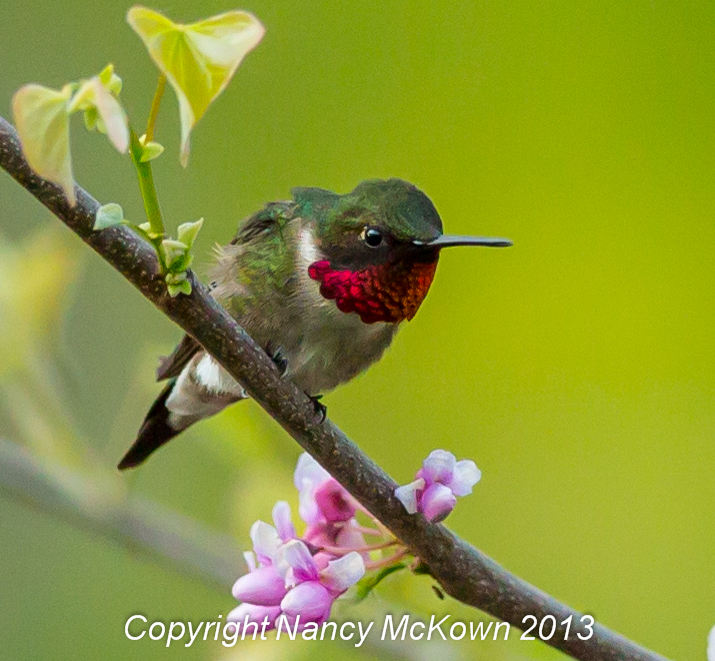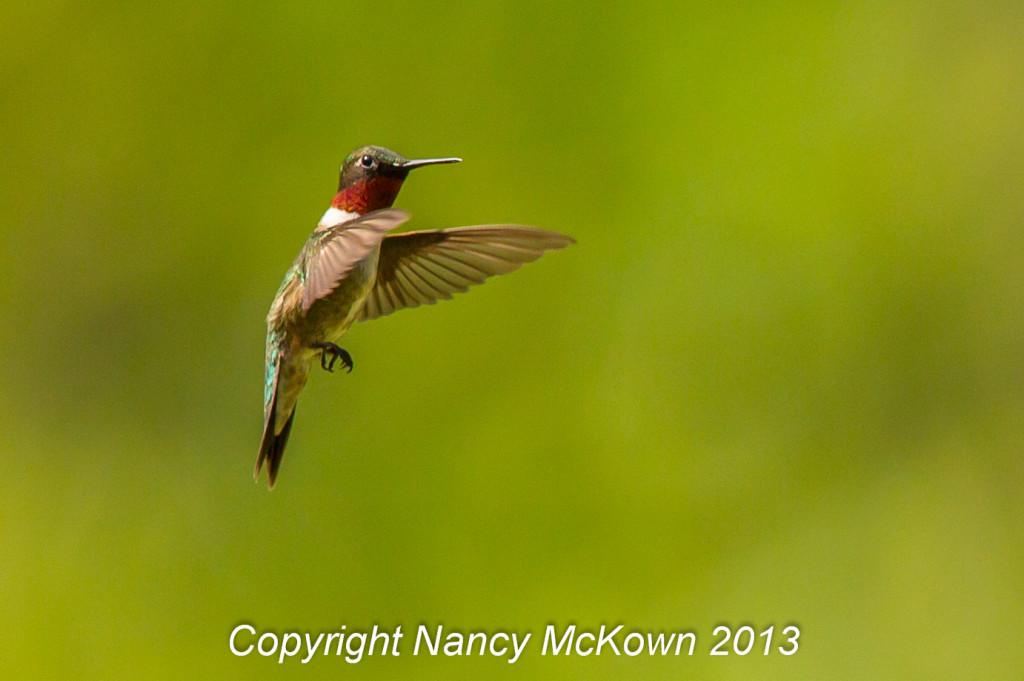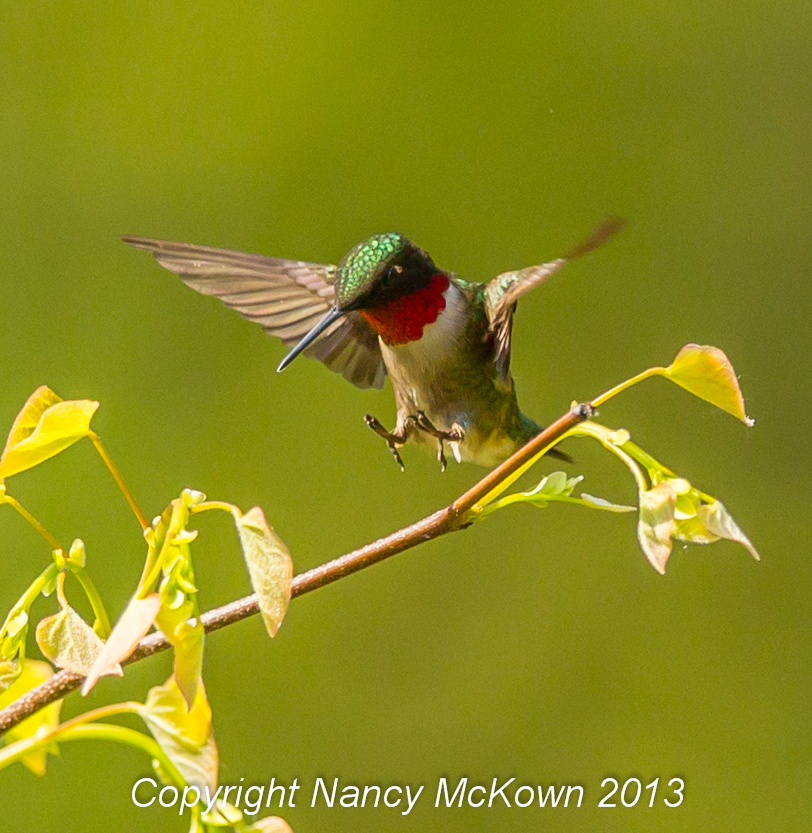Anticipating Bird Movement is Very Important When Photographing Birds
Anticipation is very important when shooting birds. (Shooting the unexpected is a whole different ball game – to be addressed later.) It requires that you research, watch, and think about bird habits, speeds, and likely territories.
You’re planning so you can calculate how best to aim your long lens in the approximate direction of where the birds might be.

Hummingbirds are my target today. I’ve taken hundreds of photos of them on the feeders. BORING! Even if you manage to get a clear shot, the hummer feeder is distracting and the background is unimpressive. You will discover that ruby throated hummingbirds are quite predictable in their habits.
How To Avoid the Boring Photographs
You must take the time to observe where these little guys go before and after they land at the feeder. First thing I observed is that some of these birds (male and female) spend a lot of precious energy chasing other hummers away from the feeders, watching, twitting, dive bombing, always fast and furious in their attempts to keep others away.
These little sentries don’t guard from a perch on the feeder, but pick a spot on a nearby branch, usually higher than the feeder, on which they stand guard on what they consider to be their territory. This spot is not particularly hidden because they need to watch and be ready for the attack on other hummers coming in for a drink.
Camera and Photographer Setup
These little humming sentries are watching you too. They need to gauge whether or not they can protect their feeders with you so close. Setting up the camera and pointing it to the “spot” and then waiting takes on a whole new dimension, because you, with your tripod, camera, long lens and stool are not the only one watching, waiting and calculating. The hummers are also busy factoring in your habits, speed and likely territory.
There’s some time involved,multiple days probably. The hummers will soon figure out that you don’t pose a threat. They will observe that you are more likely to be there in the morning and evening light, that you will be sitting very still behind the camera, watching them. After a while, they will be buzzing all around you, tho they will keep darting their little heads in your direction.
Camera ISO Settings for Sharp Photos of In Flight Hummingbirds
Techie Alert. With a certain comfort level established between you and the hummer, you must turn your attention to light, shutter speed, aperture and ISO concerns. First ISO. Hummers are tiny creatures. My longest lens is 300 mm, but from where I’m setting up (the closest I can get) the viewfinder is still mostly full of tree, with the hummer in the center. That means that once I take the shot, I must use my post processing software to zoom in to the subject on the branch.
My lens is very good and the image will be sharp, but zooming when a high ISO setting is used takes its toll on the quality of the shot. Sharpness fades with higher ISO, and gets worse the more you zoom in. The higher the ISO, the more “noise” you will see (use to be called “grain”). It’s best to keep the ISO low, like under 600 if you can manage, but certainly no higher than 1000 for tiny, far away subjects. If you can not do that, you need to get closer and fill the viewfinder more with hummer than tree.
The Impact of Ambient Light on Photographing Hummingbirds
Here is when you hope that the spot the hummer chooses to stand guard is not in direct sunlight when you are ready to take the shot. I’ve found that despite the appeal of early morning glow, early morning light won’t work because it is too dim to set my shutter speed as high as it needs to go and still maintain a relatively low ISO. (Capturing Action with Flash will be addressed in a future post.)

So I’m going to be relying on strong, but not necessarily direct, sun. Strong sun usually comes later in the day and its proximity in the sky paints unattractive shadows and washes out detail and texture on your subject. If the hummer consistently chooses a spot with direct sun from which to watch the feeder, shoot anyway to see if you get any photographs that are worthwhile.
If you don’t get any photos you like, move the feeder and start watching where the hummer re-establishes his perch.
Photographing In Flight Hummingbirds With Fast Shutter Speed
The most important setting when photographing hummers is the shutter speed. I usually start out by using “shutter preferred” option on my camera. (I set the shutter and the camera decides, based on ambient light, the settings for the aperture and ISO.) To stop action effectively, when hummers are taking off or landing, I’ve learned through trial and error, that I have to set the shutter at 1/6400 second. NOTE: When landing, hummers are slowing down, so definitely easier to anticipate the shot, but you still need a very high shutter speed.
I set the shutter speed and then look thru the viewfinder to see what 1/6400 second does to my ISO. If there’s enough light and I’m below ISO 1000, I leave it on shutter preferred, set at 1/6400 second. Think about how fast that is! I remember when the shutter speed on a couple of my old cameras did not go above 1/1000 second.
How to Focus Your Camera Lens to Stop Movement of Hummingbird Flight
Because hummers are so tiny, I choose spot focusing. Our subject is definitely spot like. I focus right on the branch where I anticipate he will land. Spot focusing can be difficult because if the subject hasn’t flown in yet, and the wind is blowing the branch, the spot focus may loose its lock on the spot area, and focus on a leaf in the stand of trees in the distance or search back and forth, unable to lock onto your chosen spot area.
Most telephoto lenses allow you to set the lens so it only searches within a certain limited range, vastly reducing the distance (front & back) that it searches. A very good lens will let you lock in the focus, so there’s no searching at all.
Of course, you can always set the lens to manual focus, though I find the auto focusing lens mechanism is much more precise at focusing than I am.
Time and Planning Needed to Capture a Special Photographic Moment
This will take time. You can not stand there behind the tripod, looking thru the view finder with your finger hovering over the shutter release. You will get stiff and begin to shake. Believe me, I’ve tried it.

First of all, there is a slight camera shake when you press that shutter button with your finger. A remote is a must, not only to save your back and reduce camera shake, but also because your eye does not have to be pressed up to the viewfinder. A remote will enable you to be more comfortable while you intently watch that hummer’s spot.
This is not the time to relax and enjoy your coffee and muffin while you gaze upon your garden. You are watching a lightning fast bird and anticipating his landing, and your finger has to be ready to press that remote nanoseconds before the hummer reaches his spot. It will be hard, but try to get comfortable.
And now, sit and wait, eyes locked on the target and finger poised to press the remote, and hope your reflexes are quick enough to capture the bird coming in for a landing, or taking off. Good Luck!









